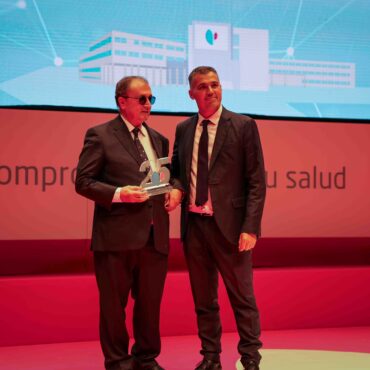chevron_left
-
 play_arrow
play_arrow
BayRadio Listen Live Broadcasting in Spain
Robotic Surgery for Prostate Cancer: What Is Radical Prostatectomy and How Does the Da Vinci Robot Improve It

share
close

Prostate cancer, sexual dysfunction, In a clinic room, female doctor appointment at the desk
Learn what radical prostatectomy involves, when it’s indicated, and how the Da Vinci robotic system enhances surgical precision, reduces complications, and speeds up recovery.
Radical prostatectomy is one of the most effective procedures for treating localized prostate cancer. It involves the complete removal of the prostate gland and, usually, the seminal vesicles. This surgery has a curative intent and is mainly recommended for patients with early-stage prostate cancer, when the tumor is still confined within the prostate and hasn’t spread to other parts of the body.
In recent years, the introduction of robot-assisted surgery using the Da Vinci system has revolutionized this procedure, enabling unprecedented surgical precision and safety. This type of surgery is recommended for clinical stages T1 and T2, aiming to completely remove the tumor before it spreads. According to specialists, it’s especially suitable for men in good general health, with a life expectancy long enough to benefit from curative treatment.
“The main goal of radical prostatectomy is to eliminate the cancer definitively before it spreads,” says Dr. Manuel Ruibal, robotic urologic surgeon at Quirónsalud Torrevieja Hospital.
From Open Surgery to the Da Vinci Robot: A Surgical Evolution
Traditionally, radical prostatectomy was performed via open surgery, which required a large incision in the lower abdomen and provided only a limited direct view of the surgical field. The emergence of laparoscopic techniques marked a step forward toward less invasive interventions. However, the true game changer was the introduction of the Da Vinci robotic system, which combines the best of both approaches with unmatched surgical precision.
The Da Vinci robot allows the surgeon to operate from a console, controlling robotic arms that perform movements with millimetric precision. This eliminates human tremors and offers a high-definition, three-dimensional view of the surgical field.
Key Differences Between Traditional and Robotic Prostatectomy
The Da Vinci robotic system marks a significant advancement over traditional open surgery. While open surgery involves larger incisions and limited vision, robotic surgery uses small incisions and offers enhanced precision and visibility.
According to Dr. Ruibal, “With the Da Vinci robot, we eliminate human tremors and achieve greater precision. This is key to preserving functions like urinary continence and sexual function.”
1. Type of incision
- Traditional surgery: Requires large incisions, which can lead to greater tissue damage and higher risk of complications.
- Da Vinci robotic surgery: Uses small laparoscopic incisions, significantly reducing tissue trauma and improving recovery.
2. Precision
- Traditional surgery: Precision depends on the surgeon’s manual skill and can be affected by tremors or fatigue.
- Robotic surgery: Offers greater stability and refined movements, enabling enhanced surgical accuracy.
3. Vision of the surgical field
- Traditional surgery: Typically provides a two-dimensional view, making depth perception more difficult.
- Robotic surgery: Offers a three-dimensional, high-definition view, vastly improving visualization.
4. Recovery time
- Traditional surgery: Recovery tends to be slower due to greater invasiveness, pain, and longer hospital stays.
- Robotic surgery: Recovery is faster, with less bleeding and trauma.
5. Preservation of key structures
- Traditional surgery: Makes it harder to preserve delicate nerves and vessels due to limited precision.
- Robotic surgery: Enhances the preservation of critical structures, reducing postoperative side effects.
Despite its futuristic appearance, the Da Vinci robot does not operate autonomously. The surgeon controls all movements from an ergonomic console in the operating room. Through small incisions, a camera and various surgical instruments are inserted. The system translates the surgeon’s hand movements into highly precise robotic actions in real time.
“The difference isn’t just in the technology—it’s in how we use it. The experience of the surgical team is crucial to fully harness the advantages of the Da Vinci system,” adds Dr. Ruibal.
Who Can Benefit from Robotic Prostatectomy?
Robotic-assisted prostatectomy is primarily indicated for patients with localized prostate cancer in its early stages. Patients must also be in good overall health to undergo major surgery and benefit from the long-term curative potential.
In some cases, the technique can also be considered for locally advanced cancer, provided that clinical conditions and a multidisciplinary team support the indication. This technique is especially beneficial for younger, physically active patients, as it helps preserve functions such as continence and sexual activity.
One of the most significant advantages is reduced intraoperative bleeding, due to the robot’s precision and minimal tissue trauma. This lowers the risk of complications and speeds up recovery. Dr. Ruibal explains, “Patients notice the difference from day one. They walk sooner, eat sooner, and go home with more independence—something unthinkable with traditional surgery.”
Other benefits include:
- Less postoperative pain, reducing the need for pain medication.
- Shorter hospital stay, usually one or two nights.
- Smaller incisions, with lower infection risk and better cosmetic results.
- Faster return to daily and professional activities.
Although concerns like erectile dysfunction or urinary incontinence persist, these side effects have significantly decreased thanks to the Da Vinci system. The robot’s ability to identify and protect nerves responsible for these functions leads to faster and better functional recovery, especially in younger patients. Still, recovery can vary and may require personalized rehabilitation.
In terms of cancer control, studies confirm that robotic surgery offers the same oncological outcomes as open surgery. The determining factor is the surgeon’s skill and experience, rather than the technique itself.
“The key lies in proper patient selection, refined technique, and detailed planning. Technology is a powerful tool, but it’s the surgeon who operates,” emphasizes the specialist.
At Quirónsalud Torrevieja Hospital, robotic surgery with the Da Vinci system has been successfully implemented for over two years. Today, the hospital is the only private center in Alicante province with this cutting-edge technology for prostate cancer treatment.
Thanks to this system, the hospital has become a benchmark in minimally invasive urologic surgery, offering patients a safer, more effective approach with better functional outcomes.
“Our commitment is clear: to offer the best in medicine through innovation. Robotic surgery is now one of our main tools in the fight against cancer,” concludes the hospital’s medical team.
Written by: Lily
Rate it
Similar posts
Recent Posts
- Quirónsalud Torrevieja Hospital celebrates 25 years of medical excellence, innovation and commitment to health
- Quirónsalud Torrevieja Hospital inaugurates the exhibition “ALTAS”, a tribute to patients and to 25 years of shared trust
- Post-operative massages? The definitive guide to ensuring the success of your cosmetic surgery
- Alzheimer’s Disease Could Double in Incidence over the Coming Decades
- A Minimally Invasive Technique Helps Control Resistant Hypertension and Reduce the Use of Medication

Ctra. Cabo La Nao, CC La Nao, Local 6 03730 Javea, Alicante, Spain
Advertise with us
Do you have a business in Spain? Do you provide a service to the expat community in Spain? Would you like your message to reach over 500.000 people on a weekly basis?
BayRadio is a community orientated radio station offering fantastic content to our many listeners and followers across our various platforms. Contact us now and find out what Bay can do for you!
Our business is helping your business grow.
BAY RADIO S.L. © 2024. ALL RIGHTS RESERVED. WEB DESIGN BY MEDIANIC







Post comments (0)